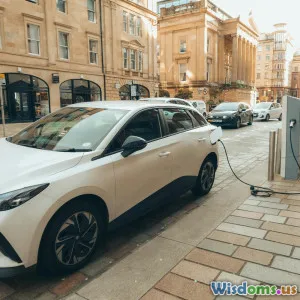
Inside the Race for the Longest Range Electric Car in 2024
8 min read Explore the cutting-edge race in 2024 to develop the longest range electric cars, redefining EV autonomy with innovative tech breakthroughs. (0 Reviews)
Inside the Race for the Longest Range Electric Car in 2024
Electric vehicles (EVs) have accelerated from niche curiosities to mainstream transportation icons within just a decade. As charging infrastructure expands and battery technology matures, the next frontier gaining keen attention in 2024 is range — how far an EV can travel on a single charge. The battle among carmakers focuses not just on raw numbers but on real-world usability, affordability, and innovation. Let's journey inside this electrifying race that promises to reshape personal mobility.
Why Range Still Matters in 2024
Despite the surge in public charging stations and growing consumer familiarity, 'range anxiety' remains a subtle but persistent concern among potential EV buyers. According to the International Energy Agency (IEA), in 2023 the average electric car range was about 300 miles, yet many buyers aim higher for peace of mind, especially those in regions with sparse infrastructure or frequent long-distance travel.
Tesla once set the bar with the Model S Plaid reaching around 390 miles, pushing competitors to redefine what "longest range" actually means. However, range is more than a single number; it encapsulates battery chemistry, energy density, aerodynamics, weight optimization, software efficiency, and fast charging compatibility. These factors all converge in the 2024 race.
Leading Contenders and Their Innovations
Lucid Air: Pioneering Energy Density
Lucid Motors revolutionized range discussions with its Air sedan, boasting an EPA-rated 520 miles in its Dream Edition Range trim. This achievement is driven by a battery pack offering up to 113 kWh, finely tuned electric motors, and a chassis designed to minimize drag with a coefficient of just 0.21.
Lucid's proprietary cell chemistry and battery module design, plus a lightweight aluminum architecture, demonstrate how pushing individual components to their limits culminates in exceptional range. As CEO Peter Rawlinson remarked in a 2023 conference, "We focused on efficiency at every step; it's not solely about pack size but how you use that energy."
Tesla Model S Plaid+: Breaking Conventional Limits
Tesla responded with plans for a Model S Plaid+ aiming for upwards of 520 miles as well, combining a tri-motor powertrain with its advanced 4680 battery cells. Though the Plaid+ model was reportedly shelved in 2023, Tesla's emphasis on enhancing battery energy density and efficiency is unmistakable.
The company’s innovations in battery pack cooling, inverter efficiency, and regenerative braking systems keep it in the forefront of pushing range boundaries.
Mercedes EQXX: Efficiency Above All
Perhaps the most remarkable contender is Mercedes-Benz’s EQXX prototype, which officially surpassed 400 miles on a single charge but emphasized energy efficiency over battery capacity. Equipped with a 100 kWh pack optimized through innovative cell technology and an astonishing drag coefficient under 0.18, EQXX highlights the synergy of lightweight materials, aerodynamic design, and AI-powered software for maximum range.
According to Mercedes engineer Markus Schaefer, "Our approach shows that it's not always about putting in bigger batteries but making smarter cars."
Technological Breakthroughs Driving the Race
The quest for longest range propels intense research in several technical domains:
Advanced Battery Chemistries
New solid-state batteries promise higher energy density and improved safety, potentially extending range by 20-30% compared to current lithium-ion packs. Companies like QuantumScape and Toyota have made strides in this arena, aiming for commercial viability in the next few years.
Vehicle Lightweighting
Using carbon fiber, high-strength alloys, and novel composites reduces weight without compromising structural integrity, directly impacting energy consumption. Every 10% reduction in vehicle weight can improve range by roughly 6-8%, according to findings from the Department of Energy.
Software and Thermal Management
Sophisticated battery management systems optimize charge cycles and thermal conditions, reducing degradation and improving nominal range over time. Smart navigation and energy-saving driving modes often add incremental gains.
Aerodynamics
Rolling resistance and drag reduction remain crucial; subtle design factors—such as active grille shutters and streamlined body panels—help cars slice through air more efficiently, especially at highway speeds.
The Real-World Impact and Future Outlook
While headline range figures impress, real-world conditions vary: ambient temperature, terrain, driving speed, and accessory use all alter performance. Consumers frequently find themselves balancing range with factors like charging time, vehicle cost, and available infrastructure.
The practical takeaway is evident: longer range expands EV adoption by enhancing functional usability for families, transport businesses, and adventurers alike. It opens opportunities in markets previously dominated by internal combustion vehicles.
Industry experts predict a tipping point around the mid-to-late 2020s when 500-mile ranges become standard rather than exceptional. This progression will likely accelerate further with deployment of next-gen batteries coupled with renewable energy grids.
Conclusion: More Than Just a Numbers Game
The 2024 race for the longest range electric vehicle is a vivid example of how innovation drives progress. Beyond just distance, it merges engineering, design, and sustainability to transform how we think about automotive freedom.
As manufacturers from startups to legacy giants vie for supremacy, consumers stand to benefit from more options, better performance, and greener mobility solutions. For anyone intrigued by automotive technology or contemplating an EV upgrade, the current momentum represents a thrilling chapter in the evolving story of electric cars.
In sum, longest range EVs are not just a benchmark — they embody our journey to smarter, cleaner, and more connected transportation.
Sources:
- International Energy Agency, Global EV Outlook 2023
- Lucid Motors Official Model Specs
- Mercedes-Benz Press Releases and Interviews
- U.S. Department of Energy Vehicle Technologies Office
- QuantumScape Battery Reports
- Tesla Battery Day Highlights 2023
Rate the Post
User Reviews
Other posts in Battery Technology
Popular Posts
















